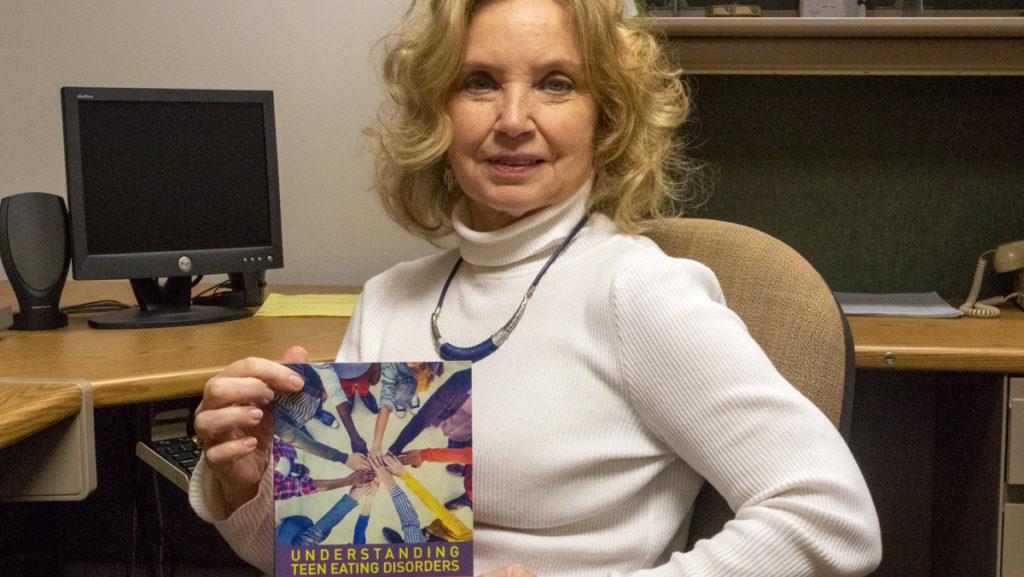Cris Haltom, a lecturer in the Department of Psychology at Ithaca College, has published a book titled “Understanding Teen Eating Disorders: Warning Signs, Treatment Options, and Stories of Courage.”
Haltom is from Massachusetts and is a certified eye movement desensitization and reprocessing therapist, family-based treatment therapist and eating disorders specialist. The book addresses teen eating disorders through the eyes of both the doctors and patients and acts as a guide for anyone suffering from a disorder. This is Haltom’s third book. Her first book is titled “Alcohol and Women,” and her second book is called “A Stranger At The Table” and addresses eating disorders by providing parents and caretakers with solutions about how to cope with the disease.
Staff writer Cody Taylor sat down with Haltom to discuss the ideas, process and content in her book.
Cody Taylor: Can you go more into detail about the case studies and your background?
Cris Haltom: I have been treating eating disorders for about 30 years. So, seven out of the eight stories that are in the book are made up by me, and they are a conglomeration of the many cases that I have done over the years. No individual who is reading my cases would recognize themselves. I am borrowing details to protect patients’ privacy. The eighth story, the person gave permission to be used in the book; the one male in the book is a real patient.
CT: Can you describe your book to me and tell me who you think will benefit from reading it?
CH: This book is the story of the patient and how they got to treatment, all the developmental factors leading up to their treatment, and it also has details about a variety of different treatment methods. … The book is for parents and for sufferers, and it is for anybody who is going to be involved in any facet of eating disorders.
CT: While writing this book, what did you hope to accomplish?
CH: Only 20 percent of teenagers with full-blown eating disorders ever make it to any kind of specialty trained care, so part of the reason to write this book is to expose people to the treatments that are out there and to show ways that they can access them, get them familiar with different levels of care and to maybe put clinicians at ease about providing that treatment. … In general, there is still a high need for education about the treatment of eating disorders, so the book is also geared toward eating disorder education and basic education about clinical treatments. … One of the pieces that this book tackles is showing only evidence-based treatments and pointing out those that are the most seriously evidence-based or have the most evidence-based support.
CT: Why did you and the other authors choose to tell the story through detailed case studies of specific individuals? How does this strengthen the novel?
CH: Stories are so much more easily read and interesting to people, so it is all in the story as they say. … I think that is a way for people to not just read dry scientific material. … All these stories are common stories. It wouldn’t take much for any clinician who has worked with eating disorders to recognize the types of cases that are dealt with.
CT: How is this book personal to you, and what got you interested in studying eating disorders?
CH: My first job straight out of clinical was a psychology internship at an adolescent and child psychiatric hospital, and I was seeing two things: a lot of sexual abuse and a lot of eating disorders. The treatments, when I first came out of my internship, were really nascent and a bit experimental, so I got really interested especially in working with adolescent girls. … Eating disorders and sexual abuse occurred in both biological sexes but were more common among gender–identified females. So I made up my mind; I was going to get special training in both of those areas.
CT: What are some of the challenges of writing a book about a topic that is so widely discussed and often misunderstood?
CH: The subject itself is challenging. The science of eating disorders has become so much bigger then it was even 10 years ago. One of the challenges is just trying to be inclusive of all of the different scientific findings. For example, the neurology, we have found, changes with eating disorders. So there are brain changes, there are neurotransmitter changes and all of those pieces need to be in that book somewhere to give a fair representation of what is going on in the field of science and how it contributes to symptoms and treatment choices. … There are so many different faces of eating disorders and that is a challenge because not only are there different ways that science has looked at this, but there are just so many symptomatic presentations. … Another big challenge that is mentioned in this book is multifaceted treatment, so we now have a list of evidence-based treatments with pretty good scientific support, but not one size fits all for people. So this book talks about how you choose which type of treatment, and it also talks about blending treatments. And that was a challenge.
CT: What are your expectations for the book? What impact do you hope it has on your readers?
CH: I hope that people are more exposed to eating disorders and are more educated about eating disorders as a result of reading the book. I hope for those who were facing an eating disorder in their family … have a much better idea what to do next, wherever they are in the process, how to address the issue that they are facing. I hope to make it a lot less scary.








